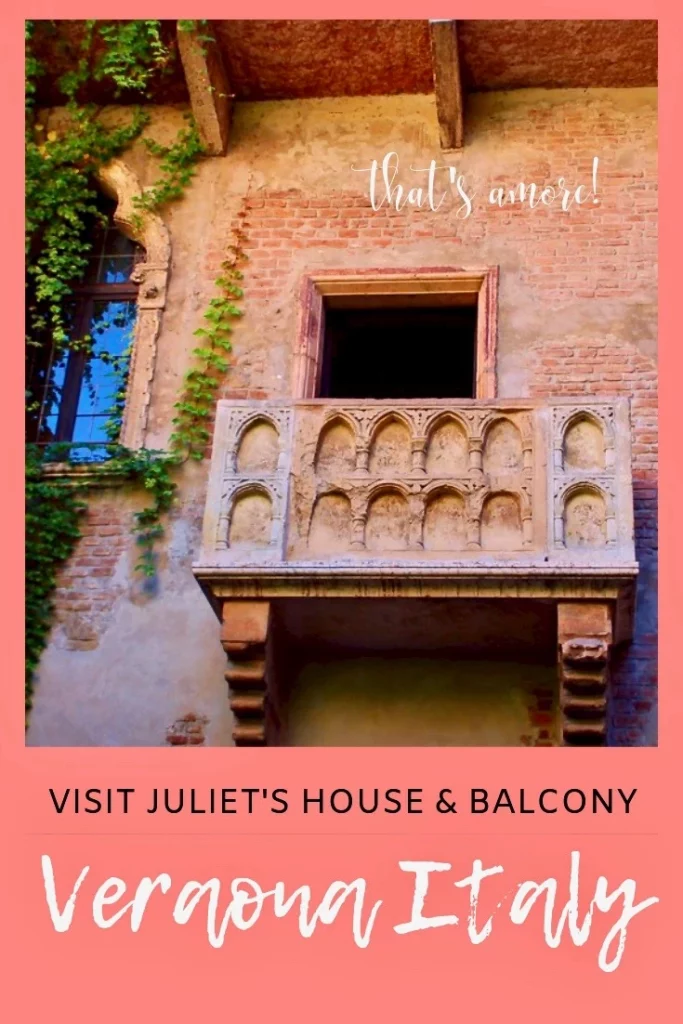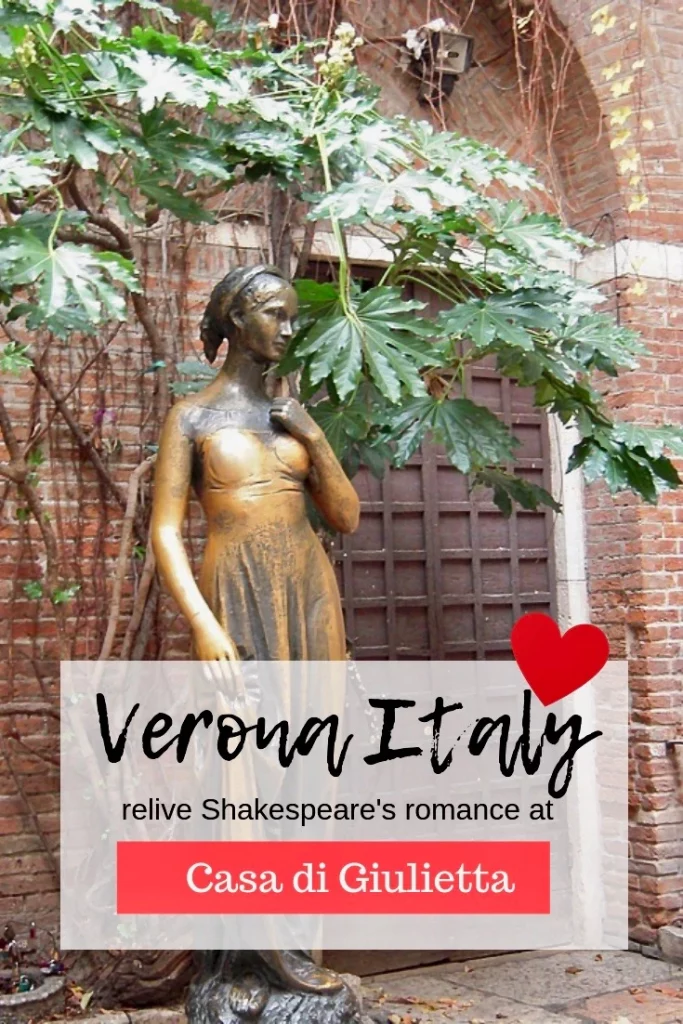“If you love someone, bring them to Verona.” — Verona Festival Slogan
Ah, Verona. Is there any city more associated with romance?
This pretty Italian town was made famous by Shakespeare’s play Romeo and Juliet. And it’s a fitting site for a high octane infusion of romance.
If you’re a fan of Shakespeare or a lover of love, be sure to head to the Casa di Giulietta or “Juliet’s House.”
I was with my teenage daughter, who was then obsessed with the Twilight vampire-themed fantasy romance novels. So a visit to Juliet’s House was mandatory.
She hadn’t yet been roughed up by life’s vagaries. She wasn’t cynical or deterred by cliche. She just wanted to bask in the romantic atmosphere, stand on the balcony, and imagine her love singing to her.
Plus, she had apparently blocked out the tragic ending. If you’ve forgotten the tale of the star crossed lovers, here’s a refresher.
Shakespeare’s Play
Verona is the setting for Shakespeare’s famous play, Romeo and Juliet, published in 1597. Set on the streets of fair Verona, the play involves an age old vendetta between two feuding families that goes tragically awry.
Romeo Montague casts his eyes on Juliet Capulet at a masked ball. They fall in love at first sight and exchange a kiss. Only later do they learn that one is a Capulet and one is a Montague. When Romeo leaves the party, he spots Juliet at the balcony. He calls out to her and they exchange vows of love.
“What lady is that, which doth enrich the hand of yonder knight? Ah, she doth teach the torches to burn bright! It seems she hangs upon the cheek of night like a rich jewel in an Ethiope’s ear! Beauty too rich for use, for earth too dear! So shoes how a snowy dove trooping with the crows, as yonder lady o’er her fellows shows. The measure done, I’ll watch her place of stand, and, touching hers, make blessed my rude hand. Did my heart love till now? Forswear it, sight! For I ne’er saw true beauty till this night. ” — Romeo
The very next day — romance zipped along back then — a friar secretly marries the couple, hoping to end the families’ feuding.
But Romeo gets in a spot of trouble when he accidentally kills a Capulet during a duel. He’s banished from Verona. The lovers are temporarily parted.
To avoid an arranged marriage her father is pushing, Juliet drinks a strong sleeping potion from the good friar, designed to simulate death. Thinking her dead, her parents entomb her. Romeo hears of her “death.” He didn’t get the note about it being staged.
He rushes to her tomb, drinks poison, and dramatically dies by her side. Moments later, Juliet wakes up and finds a dead Romeo. She kisses his lips, trying to poison herself. When that fails to do the trick, she buries a dagger in her chest.
The parents arrive. They realize that, due to their incessant feuding, they’ve lost their beloved children. They decide to bury the hatchet. Verona is now peaceful, but at a tremendous cost.
History of Juliet’s House
Juliet’s House is a gorgeous 14th Gothic building in Verona.
But, like the fictional love story, Juliet’s House is itself a fiction. It wasn’t owned by the Capulets. It’s a manufactured site. And it’s scorned by hard core skeptics.
But the character of Juliet, nonetheless, has a grip on most of our collective psyche. (Or at least my daughter’s.) It’s a rarified symbol of love in an often cynical and ugly world. It’s difficult to begrudge its fame.
Juliet’s House was actually owned by a family with a similar name, the Cappello family. They sold their house to the city in 1905. In some remarkably savvy PR branding, the city burgher declared that, henceforth, it would be known as Juliet’s House.
The iconic balcony was added in 1936 to help keep the legend of Juliet alive. It was fashioned from a 17th century sarcophagus.
In 2010, Juliet’s House became the filming location for Letters From Juliet, which unlike Shakespeare’s play has a happy ending. That only increased its fame.
Finding Juliet’s House
It’s not that easy to find.
Follow the directions to Piazza delle Erbe. You’ll see a graffiti covered sign post. You’ll pass under a dark tunnel, which is a repository for wishful dreamy romantics. It’s covered in graffiti, post it notes and old school handwritten letters. It’s called the “love wall.”
Then, you’ll find yourself in a crowded courtyard, where everyone is vying for the perfect Instagram shot.
Courtyard
In the courtyard, you’ll see Juliet’s iconic balcony. This is the fictionalized spot where Romeo serenaded Juliet. Interestingly, Shakespeare didn’t specify a balcony in the stage directions for his play. Instead, he just wrote that Juliet “appears above a window.”
In the courtyard, there’s a bronze statue of Juliet herself. This is a 2014 copy of the 1969 original by Nereo Costantini, which was so beloved that was moved to a museum due to wear and tear. Legend holds that you’ll be lucky in love if you rub Juliet’s breast.
The courtyard is free. But if you want to declare your undying love for your beloved, Juliet style, you’ll have to pay the fee to go inside. Like virtually every young girl, my daughter wanted to pose on the balcony. So we headed inside to satisfy her whim.
The Secretaries of Juliet
I was impressed to learn that the “letters to Juliet” are a real thing.
In fact, the tradition of writing letters to Shakespeare’s tragic damsel dates to the 19th century. Then, people would leave letters on Juliet’s tomb on the other side of town. Now, thousands of lovelorn people send letters to Juliet begging for advice. (The Italian version of Dear Abby)
The messages are answered by a dedicated team of volunteers known as the “secretaries of Juliet.” Working out of a room on the upper floor of Juliet’s House, they try to answer each and every letter, doling out romantic advice.
I wonder what they say … Relationship advice is a tricky thing, after all. I’m usually bereft of ideas. The human heart is so often a mercurial, feckless thing.
In the courtyard of Juliet’s House, there’s a small red letterbox affixed to the wall. This is how you can contact Juliet.
Inside Juliet’s House
The interior is somewhat sparse, but decorated with a bit authentic period furniture. There’s also beautiful frescos and wood paneling from the 15th century, You’ll have an idea of how the wealthy lived in the time of Romeo and Juliet.
You’ll see “Juliet’s Bed” and costumes featured in Franco Zeffirelli’s 1968 film. In another small room, you’ll find Juliet’s writing desk, a flower-shaped wooden table with four computer stations for visitors to write message (unless you prefer the mailbox). Consistent with the medieval theme of the house, the computers are encased in studded metal.
There’re also some lovely paintings illustrating the famous love story. It’s probably not really worth the entry fee, unless you’re determined to stand on the balcony.
If you’re lucky in love and love struck, you can even rent a room in Juliet’s House for a wedding.
Practical Information for Casa di Giulietta:
Address: Via Cappello, 23 (near Piazza delle Erbe) Verona
Hours: Open from Tuesday to Sunday 9:00 am to 7:00 pm. Monday from 1:30 pm to 7:30 pm
Entry Fees:
Entrance to the courtyard is free. Entrance to the museum is € 4 or free with the Verona Card Pro tip: Most of Verona is closed on Mondays. Juliet’s House has a different high season than most sights. It holds a love festival in February and is popular in the winter months.
If you liked it, pin it!


